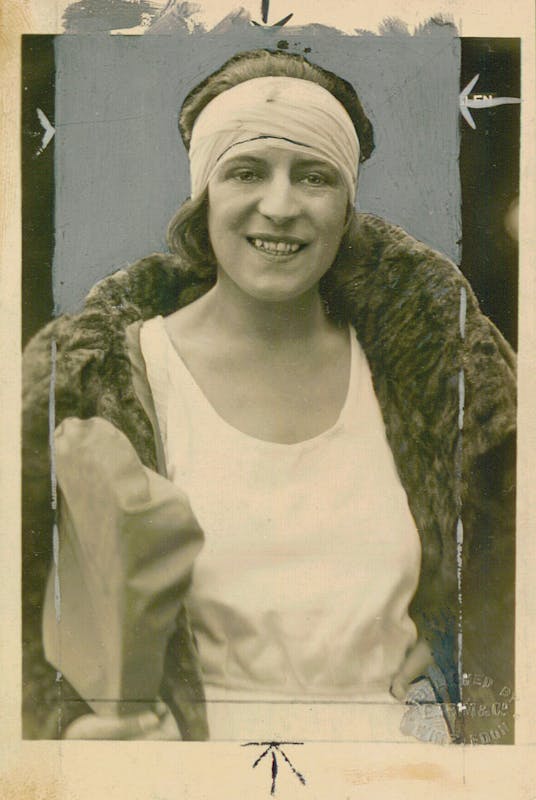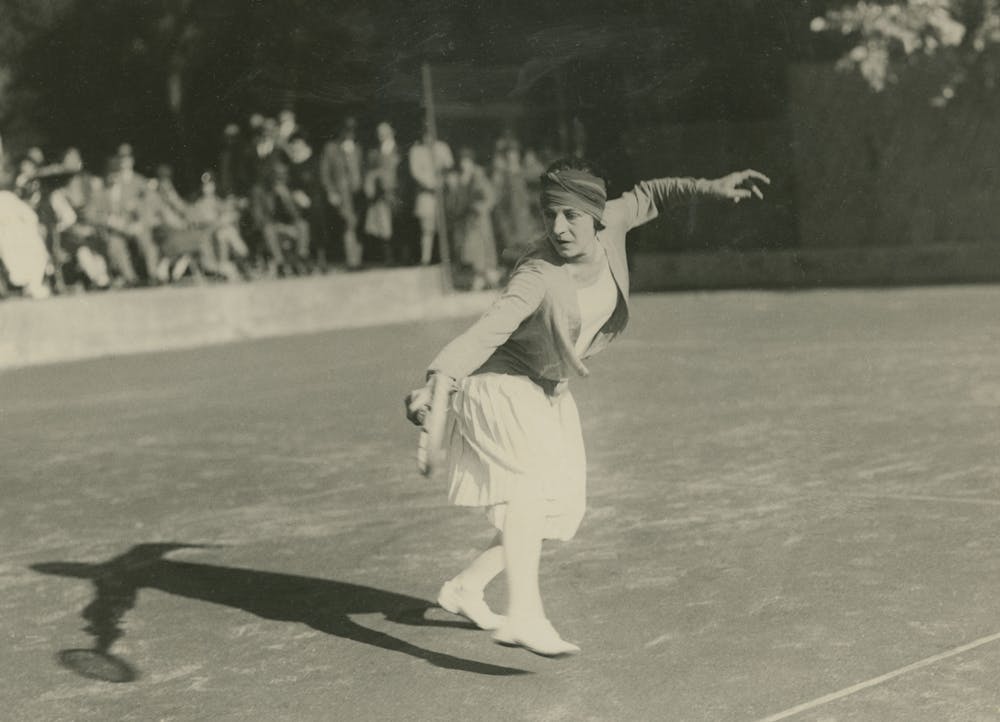This iconic player has never ceased to fascinate tennis lovers, and today, many years after her death, her name still echoes clearly around the heart of Roland-Garros stadium…
Suzanne Lenglen: did someone say icon?
Her image, her performances and her style are emblematic, it is undeniable. Suzanne Lenglen clearly felt comfortable being different, so why does this still seem so radical to us in 2021?

How Suzanne Lenglen became Suzanne Lenglen
It is 1919, at Wimbledon. Daddy Lenglen, who is sitting up in the stands, throws a silver hipflask full of brandy at his daughter’s feet. Suzanne takes a swig, draws equal then goes on to win the match, becoming the first ever Frenchwoman to win the English lawn championships.
A story of brandy, pleated skirts and audacity: this is the story of “La Divine”!
At the time, La Divine was easily recognisable. There she was, standing on the court at Wimbledon: eclectic, extraordinary, graceful, refined and light-footed, her fluid movements peppered with powerful serves, timely smashes and well-placed volleys.

And without a corset or petticoat in sight! At 20 years of age, she was the first woman in the history of tennis to come out on court wearing make-up, short sleeves and a pleated skirt worn above the knee. This pleated skirt became emblematic in more ways than one! Designed by Jean Patou, for whom she was a muse, this iconic item of clothing still features in any respectable sportswear wardrobe.
With a playing style focused on performance and centred around power, speed and fancy footwork, Suzanne Lenglen was the first sportswoman in history to consider sport as a profession, and was, above all, the first professional women’s tennis player in the history of sport.
This precocious French champion collected 81 singles titles, 73 doubles titles, 87 mixed doubles titles, and a gold medal in the singles and another in the doubles at the Antwerp Olympics.
In 1978, “the greatest female tennis player of all time” posthumously entered the International Tennis Hall of Fame as France’s first-ever professional women’s tennis player.

Suzanne Lenglen, an influential character
In the 1920s, Suzanne Lenglen lived and breathed tennis! Over the course of her career, she never stopped daring to break the rules, bringing a breath of fresh air and audacity into women’s sport, fashion, music and art in general.
A muse for some of the greatest artists, writers, musicians and composers of the time, she particularly impressed Claude Debussy, who composed a ballet inspired by the refined and light-footed playing style of this great ballerina of the courts.
A modern, free and emancipated woman, and the first-ever “celebrity” sportswoman, Suzanne Lenglen boldly flew the flag for female independence, becoming a figurehead for the Women’s Lib movement, both thanks to her exploits on court and her daring style and personality.
What did Jacques Brugnon, René Lacoste, Henri Cochet and Jean Borotra all have in common? In addition to their fantastic sporting achievements as a team, they also had a connection in the shape of Suzanne Lenglen! These four legendary “Mousquetaires” all benefitted from playing alongside La Divine: first Jacques Brugnon, whose career was relaunched the day she chose him to be her mixed doubles partner, and who went on to clinch a number of titles. Then it was René Lacoste’s turn, who Lenglen persuaded to adopt a different grip in a change that, he said, proved to be decisive. Henri Cochet copied her famous sprint to the net, and Jean Borotra, enchanted by the champion’s performance on court, admitted, “We definitely owe all of our victories to her.”
It is often said that behind every great man is an even greater woman, and the Mousquetaires are no exception!

Rediscovering an icon thanks to the new stadium
A pioneer of women’s tennis and a fabulous Roland-Garros legend, Suzanne Lenglen has certainly left her mark on the Porte d'Auteuil stadium. The stadium’s second-largest show court was named after her in 1996 and her eponymous trophy is awarded to the winner of the women’s singles tournament every year.
As the icing on the cake of the Roland-Garros stadium modernisation, Suzanne-Lenglen court will be equipped with a 21-pleat retractable roof in time for 2024. Project manager, architect and town planner Dominique Perrault explained, "I wanted to pay tribute to tennis, but also tennis during the Suzanne Lenglen era – the 1930s – and, in particular, the clothes worn at the time. Her style, her very French elegance and her famous pleated skirt. The notion of pleats was really interesting for the court’s roof, which I imagined transformed into a pleat spanning several thousand square metres.”
The project is a vibrant homage to the legendary La Divine and her signature look: the famous pleated skirt designed by Jean Patou. This majestic roof will be a quintessential blend of remarkable architectural heritage, strong symbolism and resolutely modern design.
 ROLAND-GARROS
18 May - 7 June 2026
ROLAND-GARROS
18 May - 7 June 2026

